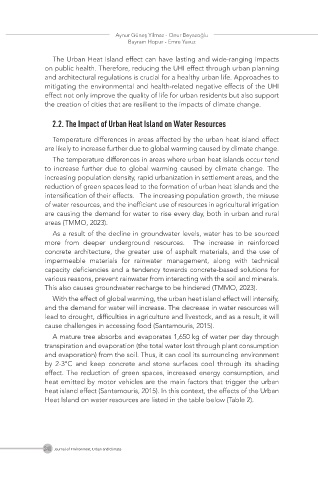Page 253 - Çevre Şehir ve İklim Dergisi İngilizce - Özel Sayı
P. 253
Aynur Güneş Yilmaz - Onur Beyazoğlu
Bayram Hopur - Emre Yavuz
The Urban Heat Island effect can have lasting and wide-ranging impacts
on public health. Therefore, reducing the UHI effect through urban planning
and architectural regulations is crucial for a healthy urban life. Approaches to
mitigating the environmental and health-related negative effects of the UHI
effect not only improve the quality of life for urban residents but also support
the creation of cities that are resilient to the impacts of climate change.
2.2. The Impact of Urban Heat Island on Water Resources
Temperature differences in areas affected by the urban heat island effect
are likely to increase further due to global warming caused by climate change.
The temperature differences in areas where urban heat islands occur tend
to increase further due to global warming caused by climate change. The
increasing population density, rapid urbanization in settlement areas, and the
reduction of green spaces lead to the formation of urban heat islands and the
intensification of their effects. The increasing population growth, the misuse
of water resources, and the inefficient use of resources in agricultural irrigation
are causing the demand for water to rise every day, both in urban and rural
areas (TMMO, 2023).
As a result of the decline in groundwater levels, water has to be sourced
more from deeper underground resources. The increase in reinforced
concrete architecture, the greater use of asphalt materials, and the use of
impermeable materials for rainwater management, along with technical
capacity deficiencies and a tendency towards concrete-based solutions for
various reasons, prevent rainwater from interacting with the soil and minerals.
This also causes groundwater recharge to be hindered (TMMO, 2023).
With the effect of global warming, the urban heat island effect will intensify,
and the demand for water will increase. The decrease in water resources will
lead to drought, difficulties in agriculture and livestock, and as a result, it will
cause challenges in accessing food (Santamouris, 2015).
A mature tree absorbs and evaporates 1,650 kg of water per day through
transpiration and evaporation (the total water lost through plant consumption
and evaporation) from the soil. Thus, it can cool its surrounding environment
by 2-3°C and keep concrete and stone surfaces cool through its shading
effect. The reduction of green spaces, increased energy consumption, and
heat emitted by motor vehicles are the main factors that trigger the urban
heat island effect (Santamouris, 2015). In this context, the effects of the Urban
Heat Island on water resources are listed in the table below (Table 2).
240 Journal of Environment, Urban and Climate

